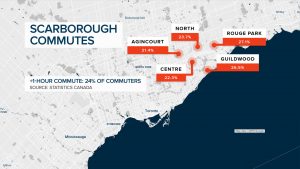#CityVote2019: the state of Toronto’s transit

Posted September 20, 2019 5:10 am.
Last Updated September 20, 2019 10:58 am.
Party leaders and candidates hit the campaign trail over a week ago and from minor infractions to bombshell revelations, the field is littered with strategies aimed at grabbing or swaying your vote.
But while party politics reaches a fever pitch over the next few weeks, there are still some core issues that will likely be top of mind for voters as they go to the polls — and in Toronto, transit is a big one.
By most accounts the city is under served by transit and the system is at capacity.
Transit expert Raktim Mitra from the Ryerson School of Urban and Regional Planning says overall, the system in Toronto is at a “choking point.”
“In downtown, our subway lines are at or above capacity during morning peak. A third of our bus and streetcar lines are over congested. So overall, it doesn’t look good.” he tells CityNews.
From David Miller’s Transit City initiative to the late Rob Ford’s call for “subways, subways subways” to SmartTrack and Metrolinx’s Regional Express Rail plans under current mayor John Tory, Mitra says there has been a lot of talk, but not enough action.
“At the rate at which we are going, we see developments at almost 15-year increments — so every 15 years we get a big project. So at [this rate], we are just trying to resolve the problems that we already have. We’re not really thinking in a futuristic way,” says Mitra.
The city’s east end, arguably the most under served by transit, has been the centre of transit planning and political debate for years. Discussions have been ongoing regarding building a one-stop, three-stop or four-stop subway line and other ideas about a possible LRT line were also in play at one point.
“Scarborough is interesting because the decisions or promises around big transit projects have been more political,” says Mitra, adding that those promises are not always driven by data.
He says there have been studies that show that a third of the total number of trips that originate in Scarborough area actually stay within Scarborough and only about 15 per cent go downtown.
“This discussion about a one-stop subway — they are all targeted toward bringing people from Scarborough to downtown. We have to think about local, non-commuter trips as well and then we’d probably be looking at a different type of solution for our transportation problems in that area.”
And even when it comes to commuter trips, Statistics Canada shows an average of more than 24 per cent of commuters in all five Scarborough ridings have more than an hour-long trip to work, putting them among the top 20 ridings in the entire country for people spending the most time commuting.

“When it comes to the bigger projects, unfortunately we’re still stuck into promises by various governments and various levels of government instead of actually trying to plan and build,” says Mitra.
Recent years have seen some movement on extending service to more areas, with the Spadina subway extension now in service and the Eglinton Crosstown LRT set to open in 2021. But the much needed Relief Line, which has now morphed into the Ontario Line is still in the planning stages.
“If we think about the bigger picture, a transit network is like a tree. And we can enrich the branches as much as we want but unless the core is strong, the system will not be efficient,” says Mitra.
“So we need more transit lines in the downtown core such as the Relief Line that has been in discussion for a long time. We that now because otherwise, five to seven years from now, we will be in a situation where nothing that we have been doing so far would really work.”










